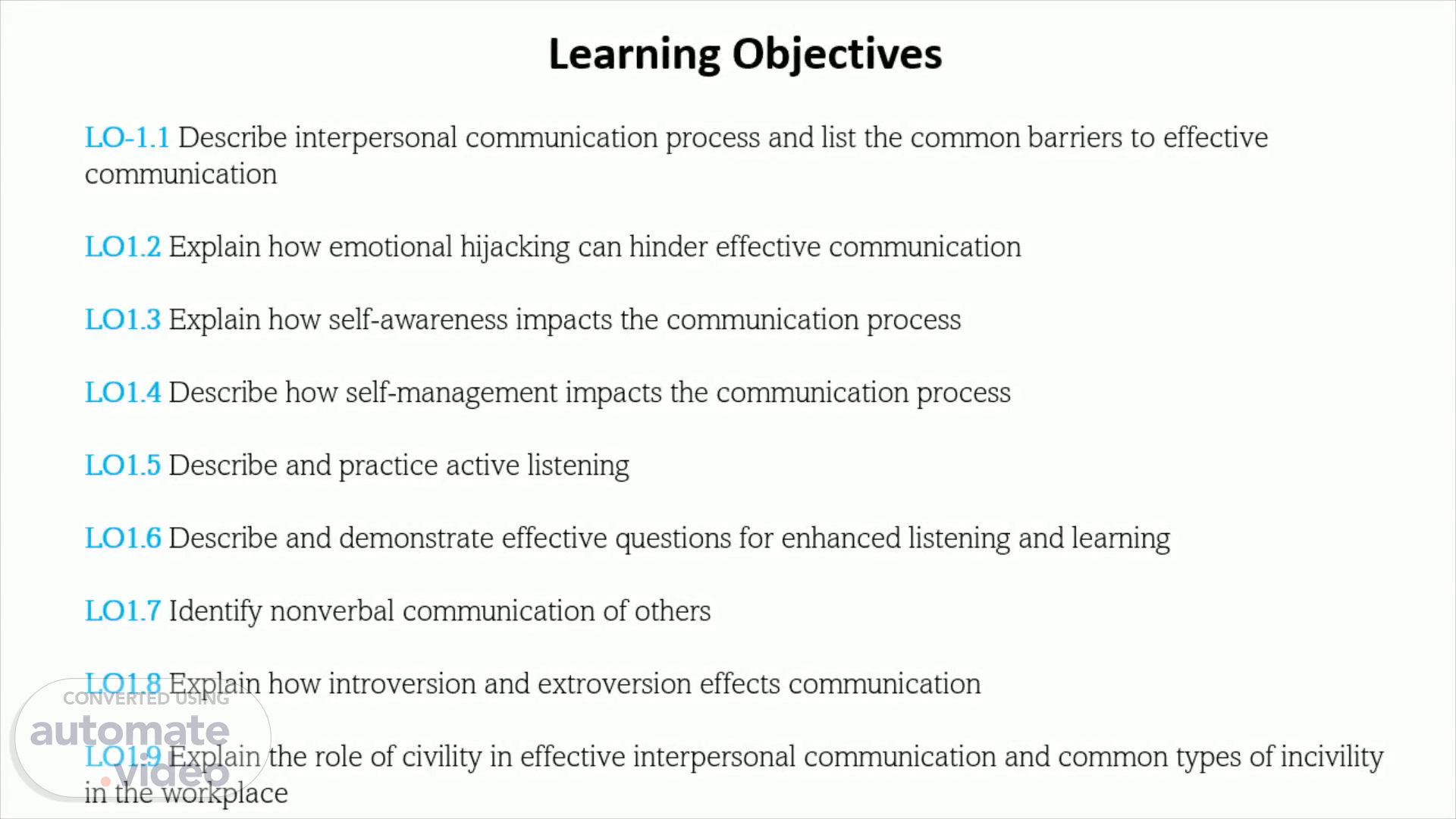
PowerPoint Presentation
Scene 1 (0s)
[Audio] After completing this lesson, you should be able to: Describe emotional intelligence and its' five domains, discover what emotional hijacking is, and learn how you can develop your emotional intelligence Identify and read nonverbal communication, ask the right questions, avoid the wrong ones, and become a better listener.
Scene 2 (27s)
[Audio] The interpersonal communication process is the process of sending and receiving verbal and nonverbal messages between two or more people. It involves the exchange of simultaneous and mutual messages to share and negotiate meaning between those involved. Each person involved in interpersonal communication is both encoding and decoding meaning. Meaning refers to the thoughts and feelings that people intend to communicate to one another. Encoding is the process of converting meaning into messages composed of words and nonverbal signals. Decoding is the process of interpreting messages from others into meaning..
Scene 3 (1m 10s)
[Audio] The goal of interpersonal communication is to arrive at shared meaning—a situation in which people involved in interpersonal communication attain the same understanding about ideas, thoughts, and feelings. In practice, many barriers interfere with achieving shared meaning, including external noise, internal noise, and lifetime experiences. Some of these barriers include: Physical noise is external noise that makes a message difficult to hear or otherwise receive. Examples include loud sounds nearby that interrupt verbal signals or physical barriers that prevent communicators from observing nonverbal signals. Physiological noise refers to disruption due to physiological factors. Examples include hearing problems, illness, memory loss, and so on. Semantic noise occurs when communicators apply different meanings to the same words or phrases. For example, two people may have different ideas about what an acceptable profit margin means. One manager may have a figure in mind, such as 10 percent. Another may think of a range between 20 and 30 percent. Semantic noise can be most difficult to overcome when strong emotions are attached to words or phrases. For example, a term such as downsize may invoke positive emotions for a manager who associates this term with frugality and wise cash management. However, another manager may view this term with negative emotions and associate it with callousness and disloyalty on the part of the corporation. Psychological noise refers to interference due to attitudes, ideas, and emotions experienced during an interpersonal interaction. In many cases, this noise occurs due to the current conversation—the people involved or the content. For example, people may have preexisting feelings or stereotypes ("he's unreliable," "she's calculating," "they will not defend us in front of management") about those they are talking to. Those feelings influence how they encode and decode messages. People also may react strongly to comments made during the conversation. For example, a listener can't stop thinking about an inaccurate statistic mentioned by a speaker or the upside of a potential deal being discussed. In many cases, psychological noise comes from sources other than the interpersonal interaction. People nearly always begin a conversation affected by moods. Perhaps they are stressed and preoccupied with thoughts of upcoming deadlines. Perhaps a person is unhappy about a lost client and has a lingering sour mood. The demanding impacts of day-to-day business activities can create psychological noise for many reasons. All outgoing messages are encoded, and all incoming messages are decoded through a filter of lifetime experiences. This filter is an accumulation of knowledge, values, expectations, and attitudes based on prior personal experiences. When people have more shared experiences, communication is easier. For example, two business managers who grew up in the same community at the same time, got engineering degrees, and work in the same company likely share enough common background in the form of shared values and experiences that they can quite easily sort through noise as they speak with one another. However, people who grew up in different communities or cultures and at different times, who have far different educational backgrounds, and who have worked in different industries are far more likely to filter incoming messages differently. As a result, they are more likely to encounter noise and are less equipped to deal with the noise..